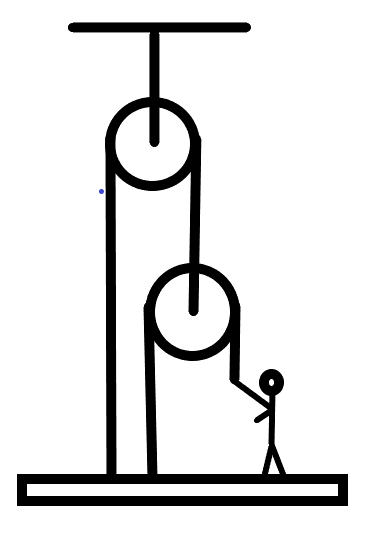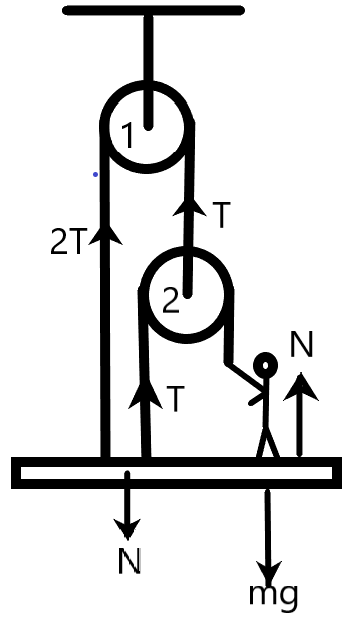
In the given diagram, with what force must be the man pulling the rope to hold the plank in position? Weight of the man is 60 kg. Neglect the weights of plank, rope and pulley.

A) 15kgf
B) 20kgf
C) 25kgf
D) 30kgf

Answer
554.7k+ views
Hint: We need to understand the distribution of the force exerted by the man among the ropes and the pulleys in the given system. The tension of the ropes can be added up to give the force that will be required to keep the plank in position.
Complete answer:
We are given a system in which a man is standing on a plank which is attached to two pulleys through ropes as shown in the figure. The man is pulling the end of a rope that is attached to the pulley 2 so that the whole system will be at rest.

We can understand that since the weights of the pulleys, ropes and the plank are to be neglected, the only force that needs to be balanced is the weight due to the man’s mass on the plank in the downward direction.
i.e.,
\[{{F}_{total}}=0\]
Let us consider the man on the plank and the tension on the rope on pulley 2 due to the force he exerts as –
\[\begin{align}
& T+N=mg \\
& \therefore T+N-mg=0\text{ --(1)} \\
\end{align}\]
Now, let us consider normal reaction of the plank and the tensions on the ropes connected to the pulleys 1 and 2 as –
\[\begin{align}
& 2T+T=N \\
& \therefore 3T-N=0\text{ --(2)} \\
\end{align}\]
Let us substitute (1) in (2) to the value for the normal reaction as –
\[\begin{align}
& 3T-N=0\text{ } \\
& \Rightarrow 3(mg-N)-N=0 \\
& \therefore N=\dfrac{3}{4}mg \\
\end{align}\]
Now, we can substitute the above relation in (1) to get the tension on the rope which will give the necessary force as –
\[\begin{align}
& T+N-mg=0\text{ } \\
& \Rightarrow T+\dfrac{3}{4}mg-mg=0 \\
& \Rightarrow T=\dfrac{1}{4}mg \\
& \Rightarrow T=\dfrac{1}{4}(60)kgf \\
& \therefore T=15kgf \\
\end{align}\]
This is the required force to be exerted by the man to keep the plank at position.
The correct answer is option A.
Note:
The tension on the rope attached to the pulley 1 becomes twice the tension applied on the pulley 2 due to the fact that the pulley 2 being only attached the other end of the pulley 1 exerts double the tension it has to experience to maintain equilibrium.
Complete answer:
We are given a system in which a man is standing on a plank which is attached to two pulleys through ropes as shown in the figure. The man is pulling the end of a rope that is attached to the pulley 2 so that the whole system will be at rest.

We can understand that since the weights of the pulleys, ropes and the plank are to be neglected, the only force that needs to be balanced is the weight due to the man’s mass on the plank in the downward direction.
i.e.,
\[{{F}_{total}}=0\]
Let us consider the man on the plank and the tension on the rope on pulley 2 due to the force he exerts as –
\[\begin{align}
& T+N=mg \\
& \therefore T+N-mg=0\text{ --(1)} \\
\end{align}\]
Now, let us consider normal reaction of the plank and the tensions on the ropes connected to the pulleys 1 and 2 as –
\[\begin{align}
& 2T+T=N \\
& \therefore 3T-N=0\text{ --(2)} \\
\end{align}\]
Let us substitute (1) in (2) to the value for the normal reaction as –
\[\begin{align}
& 3T-N=0\text{ } \\
& \Rightarrow 3(mg-N)-N=0 \\
& \therefore N=\dfrac{3}{4}mg \\
\end{align}\]
Now, we can substitute the above relation in (1) to get the tension on the rope which will give the necessary force as –
\[\begin{align}
& T+N-mg=0\text{ } \\
& \Rightarrow T+\dfrac{3}{4}mg-mg=0 \\
& \Rightarrow T=\dfrac{1}{4}mg \\
& \Rightarrow T=\dfrac{1}{4}(60)kgf \\
& \therefore T=15kgf \\
\end{align}\]
This is the required force to be exerted by the man to keep the plank at position.
The correct answer is option A.
Note:
The tension on the rope attached to the pulley 1 becomes twice the tension applied on the pulley 2 due to the fact that the pulley 2 being only attached the other end of the pulley 1 exerts double the tension it has to experience to maintain equilibrium.
Recently Updated Pages
Why are manures considered better than fertilizers class 11 biology CBSE

Find the coordinates of the midpoint of the line segment class 11 maths CBSE

Distinguish between static friction limiting friction class 11 physics CBSE

The Chairman of the constituent Assembly was A Jawaharlal class 11 social science CBSE

The first National Commission on Labour NCL submitted class 11 social science CBSE

Number of all subshell of n + l 7 is A 4 B 5 C 6 D class 11 chemistry CBSE

Trending doubts
What is meant by exothermic and endothermic reactions class 11 chemistry CBSE

10 examples of friction in our daily life

One Metric ton is equal to kg A 10000 B 1000 C 100 class 11 physics CBSE

1 Quintal is equal to a 110 kg b 10 kg c 100kg d 1000 class 11 physics CBSE

Difference Between Prokaryotic Cells and Eukaryotic Cells

What are Quantum numbers Explain the quantum number class 11 chemistry CBSE




